The Best 32 Project Management Tools 2020 [Unbiased]
From the desk of a brilliant weirdo #1:
![The Best 32 Project Management Tools 2020 [Unbiased]](/content/images/size/w2000/2023/11/im43.jpg)
From the desk of a brilliant weirdo #1:
Greetings! Thank you for checking out this article. It means a lot!
In this robust piece of content, I’ll talk to you about the top project management tools today. We’ll take a look at the best 32 PM apps:
- The most popular project management tools.
- Brand new project management tools.
- Construction project management tools.
- Open source project management tools.
- And other great project management apps as well.
We’ll break down each tool in detail so you can have a solid understanding of which software is the best for you and your team.
Without further ado:
Table of contents
- Basecamp
- Codegiant
- ClickUp
- Jira
- Asana
- Notion
- Trello
- Monday
- Paymo
- Microsoft Project
- Outlook
- Google Sheets
- Toggl Plan
- Mavenlink
- Zoho Projects
- Hive
- Workzone
- Smartsheet
- Filestage
- Proofhub
- Wrike
- Evernote
- Spike
- Ganttic
- GanttPRO
- BuilderTrend
- BuildTools
- TaskJuggler
- Freedcamp
- OpenProject
- Redmine
- Taiga
Basecamp

Basecamp is a thrilling project management app, and it’s definitely in the top 3 most popular project management software.
If you are working remotely, Basecamp is tailor made for you.
The great thing about Basecamp is its price. There’s a flat monthly fee that doesn’t take your team size into account. You would pay the same whether you have a team of 500 or 5000 people.
Features:
- To-do lists.
- Basecamp Hill Charts.
- Message boards.
- Events.
- Notifications.
- Drag and drop.
- Color-code files.
- Due dates.
- Share documents, files, and images.
- Real-time group chat.
- Pings.
- Mentions.
- Reports.
- A 30-day free trial is available. Then it starts at $99/month flat.
Pros:
- Keeping track of your team’s progress with Basecamp is super easy due to its manageable interface and robust reports.
- Some people say Basecamp is everything you need. And that can be true; Basecamp equips you with a variety of powerful features.
- It can be deemed as one of the best project management tools for to-do lists.
Cons:
- There’s a learning curve.
- Integrations are quite limited as well.
- And there’s also a lack of a wiki system.
Customer reviews of Basecamp:
“Basecamp is simple to use, with a good user interface, and does not intimidate the “non-project management” people on your team the way other project management tools do.” — Scott Perry, Sr. Project Manager at Catchers Home.
Codegiant
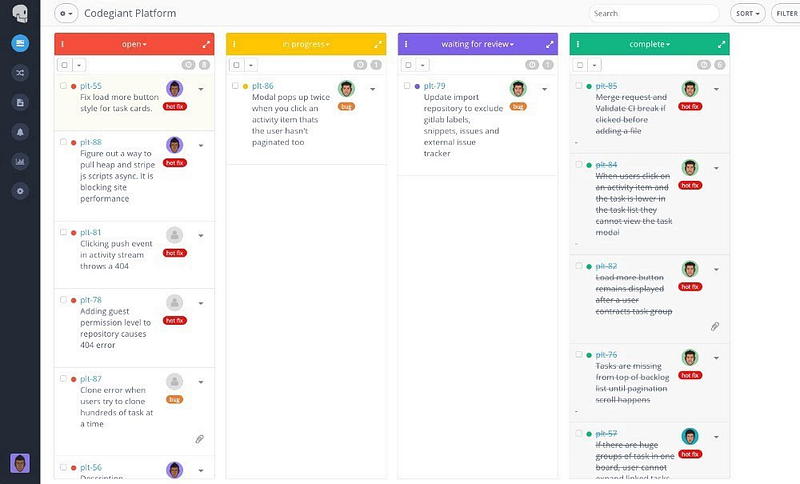
The unique thing about Codegiant is that it is PURPLE… just like Thanos.
But it’s also quite a simple project management tool with a clear UI and neat features.
Creating and spreading tasks among team members, and keeping track of your project happens without any hassle.
Features:
- Kanban and Scrum dashboards.
- Roadmaps.
- Sprints.
- Epics.
- Performance tracker.
- Subtasks.
- Tags, mentions, and comments.
- Time tracking.
- Time estimates.
- One-click Jira importer.
- Codegiant has a free plan for up to 5 users, then starts at $3/user a month.
What we like:
- Codegiant is, without doubt, in the top 3 most easy-to-use project management tools on this list of PM software. Neither it’s clunky nor challenging to comprehend.
- You can get on board in a matter of minutes. Try it for free without risking a penny.
- On top of that, Codegiant also offers git repositories, built-in CI/CD, and a publishable documentation tool. It’s the perfect pick for developers.
What we don’t like:
- As far as integrations go, we still have some work to do.
- And as much as we’d want to avoid saying that, our customer support isn’t the best in the world. We, however, learn from our mistakes. That’s why we’ll be increasing the number of our customer support team members in the next few months.
Customer reviews of Codegiant:
“The tool has a beautiful interface and works really fast. It is easy to set up and get started with Codegiant.” — Capterra.
ClickUp

“One app to replace them all.”
The main thing with ClickUp is that it has everything you need to handle your projects from end to end.
It is a project management tool that brings heaps of features to the table such as slash commands, real-time chat, task tray, comment assignments, and more.
ClickUp raised $35 million in Series A a couple of months ago which means that the ClickUp team has the budget to keep their app in top performance.
On top of that, ClickUp is one of the best free project management tools for collaboration.
Features:
- Boards, Lists, Gantt, and Calendar views.
- To-do lists.
- Docs & notes.
- Events.
- Reminders.
- Goal tracking.
- Time tracking.
- Screenshots & recording.
- Resource management.
- Performance tracker.
- Templates and custom statuses for process management.
- 1,000+ integrations with other tools.
- Free plan. If you want to get the premium features, it’s $9 per month.
Pros:
- The uniqueness of ClickUp stems from its well-made collaboration features that make the communication process a breeze.
- The support team of ClickUp is great; you’ll rarely find yourself struggling to navigate your way through the interface.
- Regular Friday feature releases; if you crave a specific feature, let the team know, and if you’re lucky, you might see it taking place the next Friday.
Cons:
- There’s a steep learning curve.
- You can’t export your ClickUp projects.
Customer reviews of ClickUp:
“The ClickUp Chrome plugin means that with the click of a button, you can start tracking time on a task without having to go onto the main site.” — Lydia German, Digital Marketing Executive at Tao Digital Marketing.
Jira
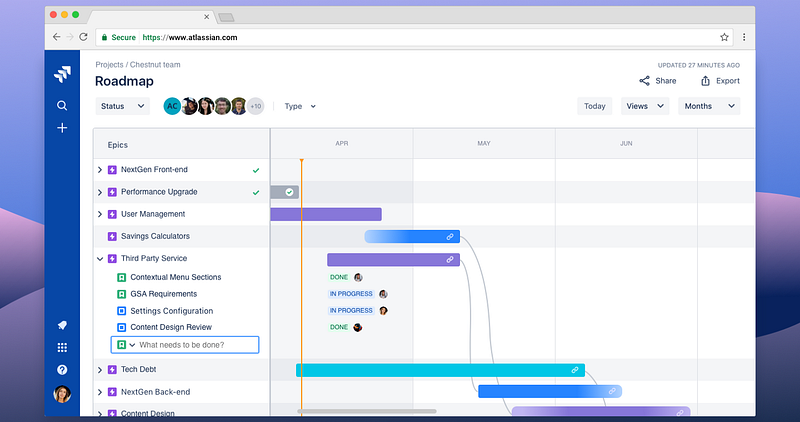
Jira definitely ranks in the top 3 for the most popular project management software.
It dates back to 2002, and it was initially designed as an issue tracking system. But with time, it evolved into more of a project management tool.
Today, it’s trusted by more than 65,000 teams.
Jira is perhaps the most robust and feature-rich tool on the market.
Features:
- Roadmaps.
- Customizable Jira boards.
- Kanban, Scrum and Scrumban boards.
- To-do lists.
- Custom fields.
- Swimlanes.
- Search.
- Filtering.
- Resource planning.
- Advanced reporting.
- Advanced security and administration.
- Android and iOS app.
- Jira also has Windows, Linux, and Mac desktop project management applications.
- Free for open-source projects and for teams with up to 10 users. Then starts at $7/user/month.
Pros:
- Jira can integrate with a variety of other apps, bringing your entire project management workflow into one place.
- Jira’s support team is simply phenomenal. Fast, reliable, and always with a positive attitude.
- Although it’s one of the best task management software for developers, Jira also works great for general project managers.
Cons:
- It isn’t suitable for non-technical people. Jira’s initial issue tracking design has influenced the software’s evolution over time, and has made the UI hard to grasp, especially if you aren’t a developer.
Customer reviews of Jira:
“It doesn’t matter if the project is small or large — Jira will allow you to customize the project for any needs.” — Ilya Vilmitskey, Project Manager at Exyte.
Asana
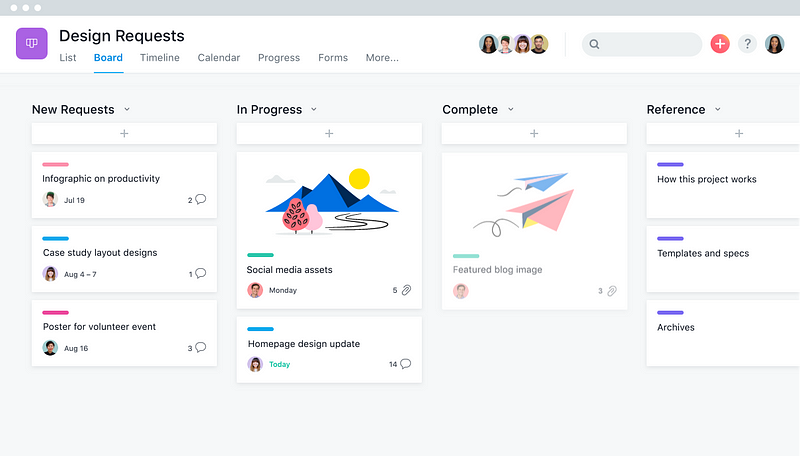
Founded by Dustin Moskovitz, Co-Founder of Facebook, Asana stands up there with the most popular project management tools.
Asana’s interface is super interactive, and keeps you engaged during the whole time you’re using the app. What’s more, rainbow unicorns appear on the screen when you complete a task successfully.
Asana offers more than 100 app integrations. It can bring everything you need in one place — emails, tickets, files, and more.
Features:
- Simple interface.
- Document management.
- Asana timelines — Gantt charts.
- Reports.
- Notifications.
- Reminders.
- Comments.
- Add assignees, attachments, and hearts to tasks.
- Time tracking.
- It comes with a free plan for up to 15 users. It then starts at €13.49 billed monthly.
Pros:
- Navigating through Asana is easy. Creating an account and logging in is fast and easy.
- Creating and spreading tasks across the team is frictionless.
- Asana equips you with a bird’s eye view of your progress so you can see who is doing well and who is falling behind.
- Asana seems to be one of the best task management software for a lot of managers because of its intuitiveness and robustness.
Cons:
- Asana can get very laggy at times, especially when you’re opening an Asana task from an external link.
- Email notifications can be hard to disable.
- The pricing isn’t cheap. Compared with other project management systems, Asana can dive deep into your pockets. The premium plan is priced at $13.49/user per month.
Customer reviews of Asana:
“Asana is cloud-based and lets our team easily organize tasks and projects, communicate and collaborate. The different display options mean that you can choose the look that is easier for you to work with.” — Ahmed Mir, Founder at Sip Coffee House.
Notion
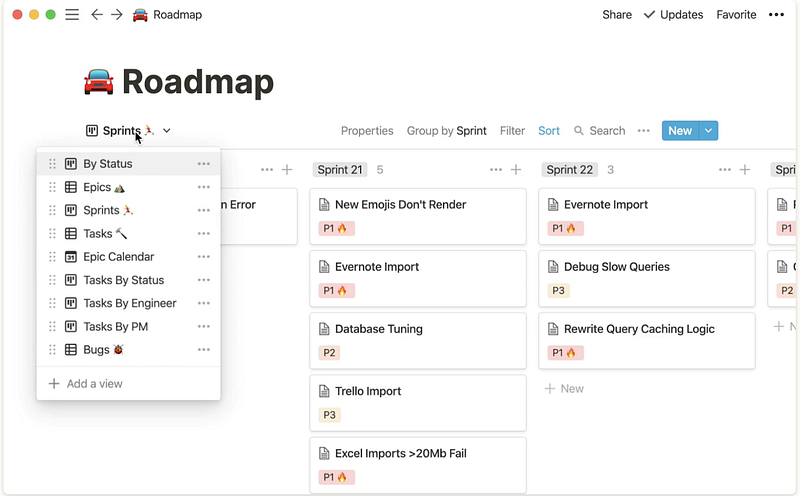
If you were to ask Steve Jobs what is his favorite project management app, he would probably point out Notion because of its neat and simple design.
Notion is extremely easy to use. Navigating your way through the app feels like a breeze.
There aren’t many features all over the place to make you feel like you’re working in a dumpster fire. Everything is neat and clear.
As an individual user, you can use Notion for free. It’s simply the perfect project management tool for personal use.
Features:
- Kanban boards.
- To-do lists.
- Notes & docs.
- Wikis.
- iOS and Android apps.
- Markdown.
- Slash commands.
- Drag and drop.
- Comments, mentions and assigns.
- Real-time editor.
- Notion has a free plan for personal use. The “Personal Pro” plan that starts at $4.
Pros:
- Notion works great for both personal and business needs.
- The Notion dashboard is clean and distraction-free, allowing you to fully focus on the task you’re working on.
- Sharing info with clients and other members of the team is effortless.
- The mobile version of the app is shockingly simple to use. People believe Notion should be charging more for the value it offers.
- It’s perhaps the #1 task management software for to-do lists.
Cons:
- There’s no integration with Google Calendar for tracking due dates.
- No offline mode for the desktop app.
- Some people say it can be buggy at times.
Customer reviews of Notion:
“One of the great things about Notion is that it provides you with a set of building blocks to be able to create your own layouts and toolkit that works best for you and your team.” — Karl Robinson, Director & Co-founder of Logicata.
Trello
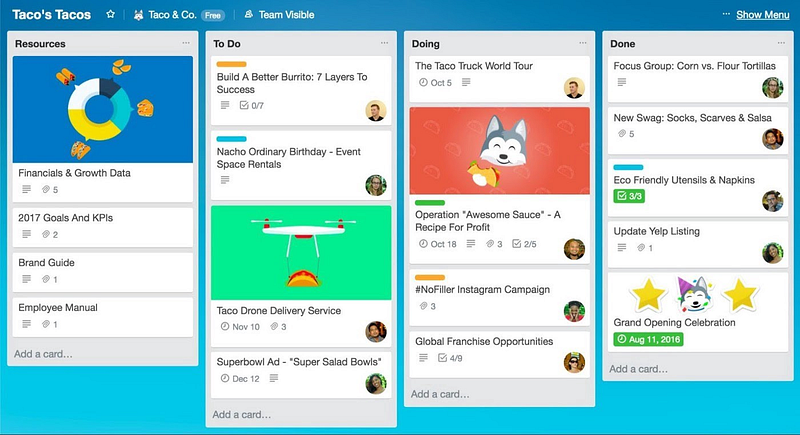
If you have a hard time tracking your team’s progress, then you need Trello. It’s one of the top time tracking software.
With Trello’s intuitive interface, you can simply glance at your dashboard, and see the progress being made, who is working on schedule, and who is falling behind.
Trello also brings powerful features to the table such as boards, cards, and lists, allowing you to organize your projects without any hassle.
Trello is suitable for both business and personal projects.
Features:
- File attachments.
- Checklists.
- Labels.
- Search.
- Filters.
- Due dates.
- Drag and drop.
- Discussions.
- Notifications.
- Emojis.
- Android and iOS apps are available.
- Trello pricing plans at $12.50 per user per month.
Pros:
- Trello is a lighting-fast project management tool. The interface is so simply designed that you don’t need to go through any product tours to get the hang of it.
- You can update or add info to your cards effortlessly.
- Tracking your project’s progress is super easy because of Trello’s clear dashboard views — definitely one of the best task tracking tools.
Cons:
- Your dashboard can turn into a clusterfuck, if you create hundreds of tasks. It becomes quite hard to keep track of everything. Trello is better suitable for smaller teams.
- The Business and Enterprise plans don’t offer free trials, so you can’t really try Trello’s premium features unless you buy it.
- The mobile app is a bit messy; you can lose track of your messages and info updates.
Customer reviews of Trello:
“I’ve tried to use a lot of project management programs in the past and this is the best tool that worked for us. Aside from the app being offered for free, it has a lot of tools that will make your work life easier.” — Willie, Founder of The Product Analyst.
“What’s great about Trello is that it gives a remote team a bird’ s-eye view on the current project and ensures the team delivers on its amalgamated goals.” — Max Woolf, Career Expert at ResumeLab.
Monday
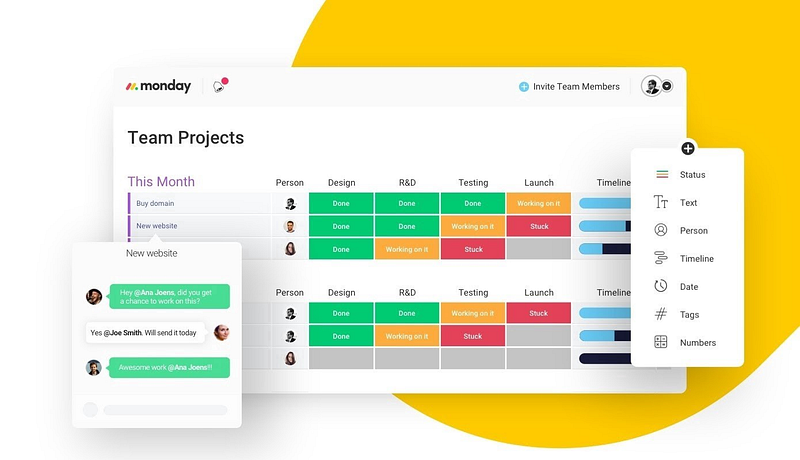
Monday can be easily named as the project management tool of the year.
It’s simple, it’s straightforward, and it’s pleasant to the eye.
With Monday, you won’t be spinning your wheels as you’d be with other clunky PM tools.
Features:
- Automated notifications.
- Task dependencies.
- Kanban boards.
- Time tracking.
- Integrations.
- Timeline views.
- Gantt charts.
- Project management collaboration tools.
- Email updates.
- Customizable templates.
- Milestone tracking.
- Monday comes with a Mac project management software.
- It offers a free trial. After the trial ends, the price starts at $39.00 per month for 5 users.
What we like:
- The drag and drop features make everything so much easier.
- Keeping your teammates up to date with Monday.com is very, very easy.
- Monday’s collaboration features are simply great — you can put your team on the same page easily.
- Integrates with a variety of other apps.
- Monday is simply an amazing team management software that fits every project manager’s needs perfectly.
What we don’t like:
- It can be a bit expensive compared to other PM programs.
- It can be laggy at times when navigating through the UI, especially when you’re using the Mac app. Many people believe that Monday doesn’t have the servers to sustain its large customer base.
Customer reviews of Monday:
“I love the comment threads, the ability to truly customize columns so we can build our own workflows.” — Elizabeth Harrin, Director of GirlsGuideToPM.
Paymo
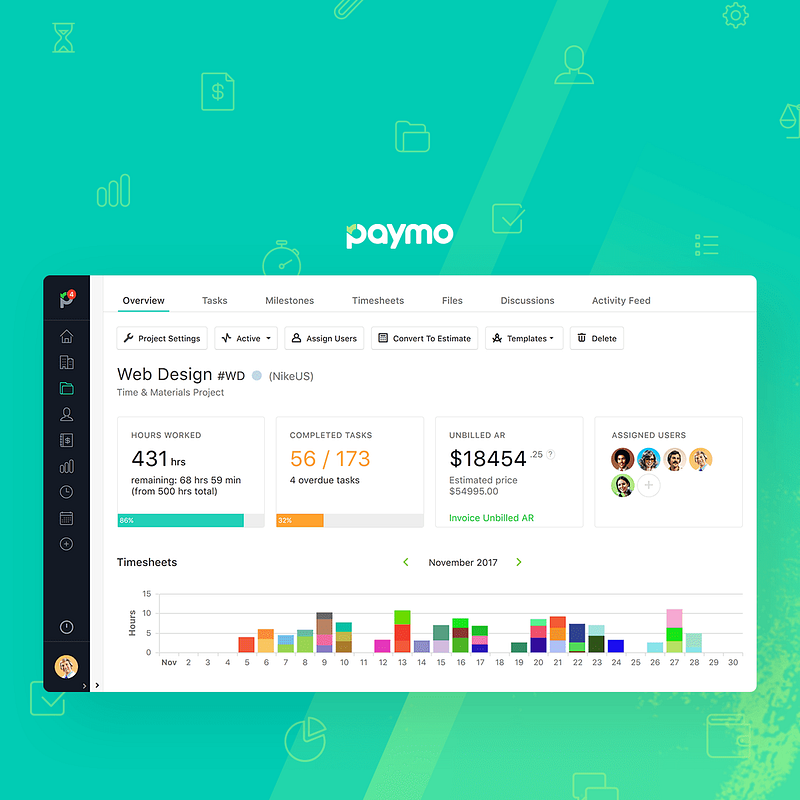
Paymo does a really great job at combining essential project management elements in one place — simplicity, features, and visibility.
Paymo is a tailor-made project management software for remote and small teams.
With Paymo, you can accurately assess your team’s performance because of the robust reports you’ll have access to.
Features:
- Kanban boards.
- Gantt charts.
- Time tracking.
- Budget management.
- Customizable templates
- Milestones.
- Reminders.
- Paymo comes with a 15-day free trial. The “Small Office“ plan starts at $11.95/user per month.
Pros:
- You don’t need to use 3rd party tools; Paymo takes care of your project management process from end to end.
- Freelancers like Paymo a lot because it allows them to collaborate with clients and send invoices easily.
Cons:
- There’s quite a learning curve you’ll need to overcome.
- The interface gets clunky when you create tons of tasks; it’s hard to sift through.
Customer reviews of Paymo:
“Paymo is tremendously helpful in keeping me productive and organized.” — Jane Flanagan is the Lead Project Engineer at Tacuna Systems.
Microsoft Project
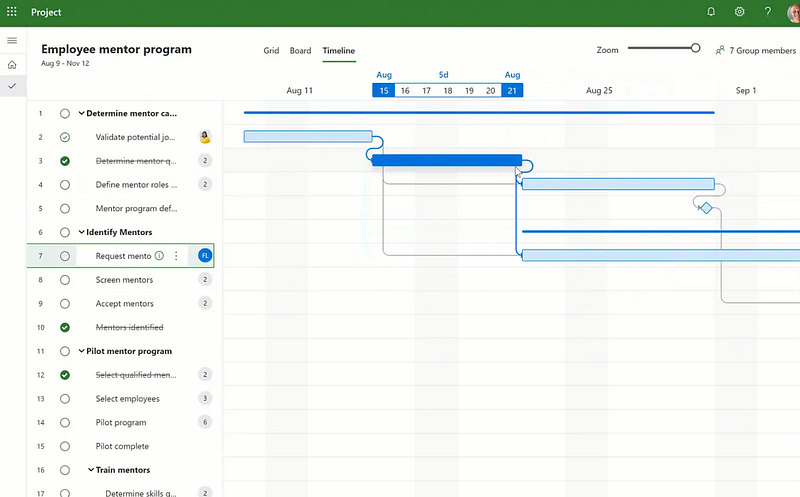
Microsoft Project is one of the simplest project scheduling software tools on this list.
It comes with powerful features to help you plan, manage, and deliver work without missing deadlines.
It works perfectly for small and large projects.
Features:
- Interactive dashboards to view the overall status of your projects.
- Automated project management workflows.
- Gantt charts.
- Task and status updates.
- Integrates with MS planner.
- It’s built on Azure.
- Microsoft Project has cloud-based and on-site solutions. Prices start at $10/user/month.
Pros:
- One of the main perks of Microsoft Project is its simplicity. You’ll be able to plan work and organize tasks without any hassle. The platform is truly user friendly.
- What’s more, it offers many templates so you can hit the ground running almost right off the bat.
Cons:
- The project progress tracking seems to be a bit complex.
- There’s a steep learning curve.
- It’s a bit expensive compared to other tools on this list.
Customer reviews of Microsoft Project:
“My favorite project management tool is Microsoft Project, still. I can manipulate the software to provide progress on task, illustrate the assigned resources as well as document the start and finish dates as high level or drilled down as I would like.” — Alexis Nicole White, PMP, SMC.
Outlook
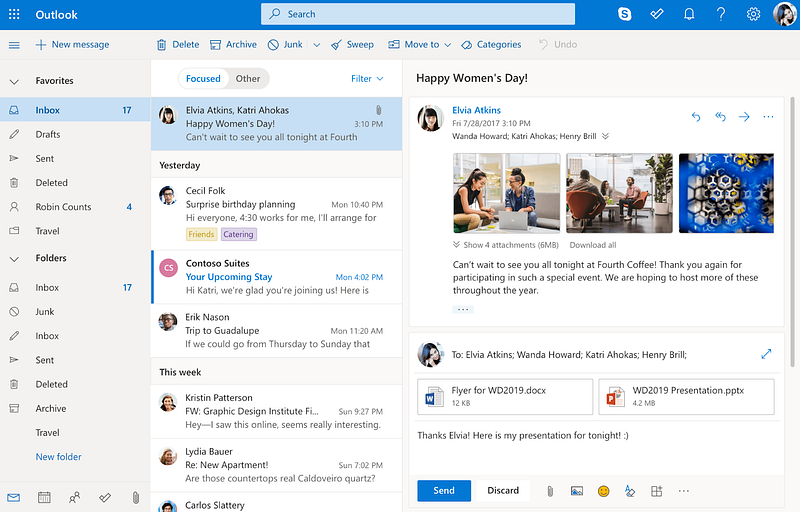
If you are a fan of Outlook and would like to use it as a project management tool, that’s absolutely possible.
Outlook has a number of features that can be used for project management.
The great thing about Outlook is that it’s straightforward to use.
Features:
- Tasks.
- To-do lists.
- Calendar view.
- Alerts.
- Time tracking.
- Overview of your colleagues’ roles and responsibilities.
- Milestones.
- Resource management.
- Accessible by everyone.
Pros:
- Relieves you of the pain of adopting 3rd party project management systems.
- Outlook boasts well-designed team communication features. You’ll be able to keep everybody on the same page.
Cons:
- Well, at its core, Outlook isn’t a project management tool and lacks a lot of core features that other PM tools support. Yet, if you’re looking for something simple, you can’t go wrong with it.
Customer reviews of Outlook:
“I like the user interface, it’s very easy to communicate with team members.” — G2.
Google Sheets
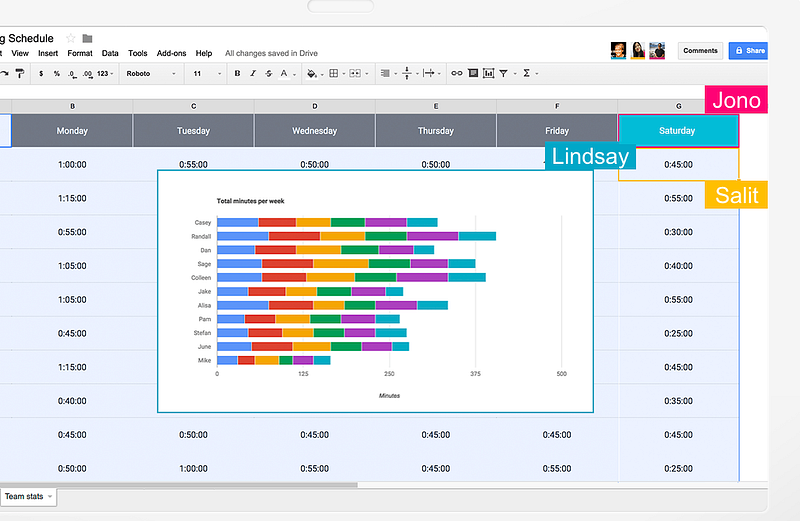
Google has a lot of project management tools like Google Docs, Google Slides, and others, but the one that really stands out is Google Sheets.
It is flexible and easy to use.
With Google Sheets, you can create, edit, and collaborate your assignments on the fly.
Features:
- Templates.
- Spreadsheets.
- Notes.
- Docs.
- Calculator.
- Collaboration tools.
- Works on Mac, Windows, Web-based, cloud, SaaS, iPhone / iPad, and Android.
- Google Sheets is a free project management software.
Pros:
- Getting started with Google Sheets is frictionless; there is no steep learning curve to overcome.
- Sharing files with others is extremely easy.
- Some people say that Google Sheets relieves the eyes especially if you’re coming over from Microsoft products.
- Google Sheets is simply an incredible project planning tool that can fully satisfy a project manager’s needs when it comes to planning and tracking projects.
Cons:
- Although Google Sheets is quite simple at its core, the more advanced features (like duplicates) require more digging into the app and understand its features thoroughly.
- Not as good as MS Excel in terms of robust features.
Customer reviews of Google Sheets:
“I love how easy it is to work with and how it allows me to access it from around the world. It is easy to set up and works great with both apple and android.” — Capterra.
Toggl Plan

Toggl Plan is a project scheduling software that offers all the features you need to ease your end-to-end project management process. Organizing tasks, managing teams, and creating detailed reports feels like a breeze.
What’s great about Toggl Plan is that it can give you a 50,000 foot view over your tasks, allowing you to see the “What,” “When,” and “How” of your project.
Features:
- Drag and drop.
- Plan and collaborate in real time.
- Instant updates.
- Checklists.
- Easy sharing.
- Custom colors.
- Milestones.
- Zoom levels.
- Upload files.
- There’s a free plan for up to 5 users. Then it starts at $9/user/month.
Pros:
- The cool thing about Toggl Plan is that it focuses on one specific thing — planning projects — and it doesn’t overwhelm you with a variety of features.
- You can improve your team’s performance by recalling what went well and wrong with previous projects thanks to milestones.
Cons:
- Some users have complained about the high-contrast design creating too much distraction.
Customer reviews of Toggl Plan:
“I like how it doesn’t try to do too much. It focuses on what it’s best at — planning projects and project management tasks over periods of time for teams.” — Capterra.
Mavenlink

Mavenlink is another fantastic project scheduling software that combines many essential features (resource management, time management, budget management, and more) in one but powerful project management app.
With Mavenlink, you don’t need integrations with 3rd party tools turning your workspace into a clusterfuck.
Features:
- Task management.
- Documentation.
- 24/7 support.
- Collaboration tools.
- Email integration.
- Gantt charts.
- Time tracking.
- WIP limits.
- Invoicing.
- SSL security.
- File sharing.
- You can try Mavenlink free for 10 days. Mavenlink prices, however, aren’t disclosed on their official website; you need to contact their team to get a quote.
Pros:
- Mavenlink comes with great tracking features. Having the ability to accurately track your team’s performance will help you make better time and cost estimates.
- Another great thing about Mavenlink is its robust reports. You’ll receive insights that will allow you to enhance your team’s performance and never miss a deadline again.
Cons:
- The UI can be a bit clunky. You may need a couple of days to get the hang of it if you haven’t used Mavenlink before.
Customer reviews of Mavenlink:
“The reporting functionality Mavenlink offers is extensive and has enabled us to get much better visibility to our project, program, portfolio and resourcing data.” — Capterra.
Zoho Projects
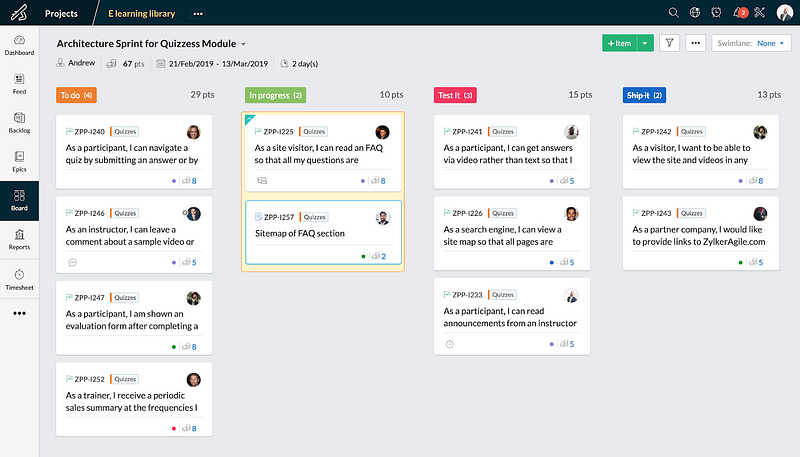
Zoho Projects is an online project management software that allows you to track your project’s progress down to the smallest detail.
Zoho comes with burndown charts, burnup charts, and cumulative flow diagrams. You’ll be able to learn from past projects quickly, and improve future ones easily.
Features:
- Cloud-based project management solution.
- Kanban boards.
- Scrum boards.
- Great visibility.
- Collaboration tools.
- Customizable templates.
- Time tracking.
- Milestone tracking.
- Zoho Projects offers a free trial. And after that, it is €3/user/month.
Pros:
- The support team is flawless; they act quickly and solve problems easily.
- The well-designed dashboard views allow you to clearly see the right steps you need to take.
- It’s one of the best project planning tools you can try for free.
Cons:
- As with many PM tools, the UI can turn into a dumpster fire if you overload it with a multitude of project management tasks.
Customer reviews of Zoho Projects:
“Zoho Projects helps streamline my team and all the available tasks in a unified and simple manner.” — Mark Jenner, Founder of FoodFireFriends.
Hive
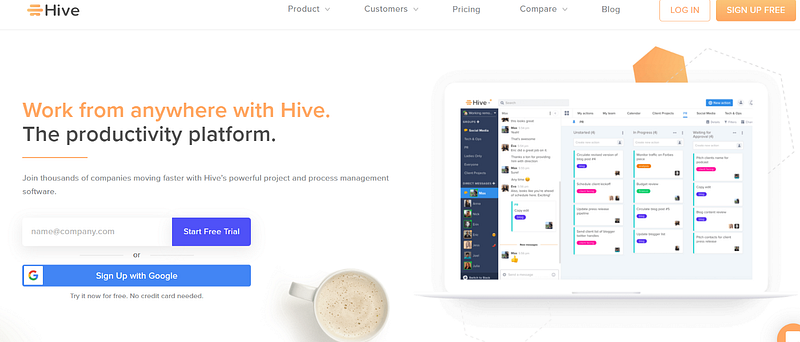
Hive is one of the best project management tools to bring your entire team on the same page. Its collaboration features are simply outstanding.
With Hive, you’ll get access to flexible project layouts, native email, group messaging, and file sharing so you can make all communication with your team members flawless.
On the whole, Hive is definitely one of the best project management tools.
Features:
- Gantt charts.
- Kanban boards.
- Time tracking.
- Portfolio management.
- Collaboration tools.
- Customizable templates.
- Milestone tracking.
- Hive offers a free trial. After the trial ends, it’s $16 per month per user.
Pros:
- Hive’s UI is quite user friendly; you’ll have an easy time shuffling through your tasks.
- The support team is simply great.
Pros:
- The web-based application can be unresponsive at times. Sometimes, you might get a blank page when you try to load the Hive app.
Customer reviews of Hive:
“The set up was intuitive and straightforward. It offers flexibility in terms of how we sort and view projects.” — Daniel Seeff, CEO at Foot Cardigan.
Workzone
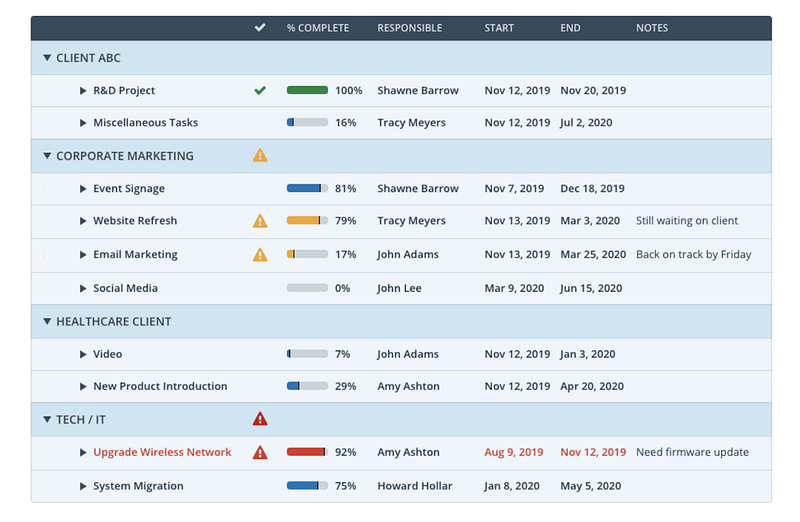
Workzone is a straightforward project management tool.
Unlike other feature-rich project scheduling software, Workzone focuses on providing a clear overview of your projects so you clearly see the direction your project is moving toward.
Moreover, it has great reporting features that will help you improve your team’s performance significantly.
Features:
- Project Dashboard.
- To-Do Lists.
- Gantt Chart.
- Status Alerts.
- Project Templates.
- Time Tracking.
- Secure File Sharing.
- Image Markup.
- Email Alerts.
- Discussions.
- Mac project management app.
- Custom Branding.
- Unlimited Support.
- API & Integrations.
- Prices start at $24/user/month.
Pros:
- The Mac app runs like water.
- Workzone offers great collaboration features allowing your team to stay on the same page.
- Workzone’s customer support is second to none.
Cons:
- Assigning tasks to external members of the project can be quite difficult.
- Also, filtering your projects is hard and tiresome.
- The tool can be quite expensive.
Customer reviews of Workzone:
“I really like the features and functionality and the customer service for this tool. You can tell that the company really cares.” — Capterra.
Smartsheet
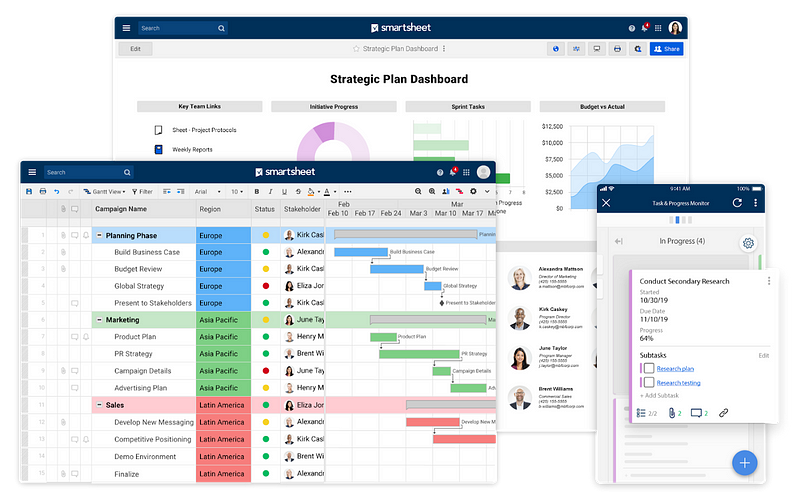
Smartsheet is more of an enterprise project management software that comes with heaps of features helping you to manage your projects easily.
Nevertheless, you can still use it if you are a small company, especially if you are in dire need of free excel project management tracking templates.
Smartsheet offers all kinds of excel templates. All the templates are neatly structured so you can just fill in your data and hit the ground running.
You don’t need to be a tech guy or gal to work with Smartsheet.
Features:
- Dashboards.
- Data charts and key metrics.
- Many integrations.
- Grid, Gantt, card, and calendar views.
- Attach files.
- Nesting tasks.
- RAG status.
- Date duration.
- Reminders.
- Forms.
- Reports.
- Update requests.
- Sharing.
- Filters.
- Android and Mac project management applications are available.
- Custom branding.
- You need to contact their team to get a price quote.
Pros:
- Smartsheet’s support team acts fast, and ensures you have a great experience with the PM platform.
- What’s more, you can automate tedious tasks such as sending alerts and updates, requesting approvals, and more to ease your work process.
Cons:
- When it comes to calculating, Smartsheet isn’t as good as Excel is.
- The UI is quite hard to grasp.
- Because you have so many features, onboarding can be a bit difficult. You may need additional training for the advanced features.
Customer reviews of Smartsheet:
“Smartsheet is very useful for managing client projects because of its strength in collaboration and onboarding.” — Erin Koss, CEO at Syte Consulting Group.
Filestage
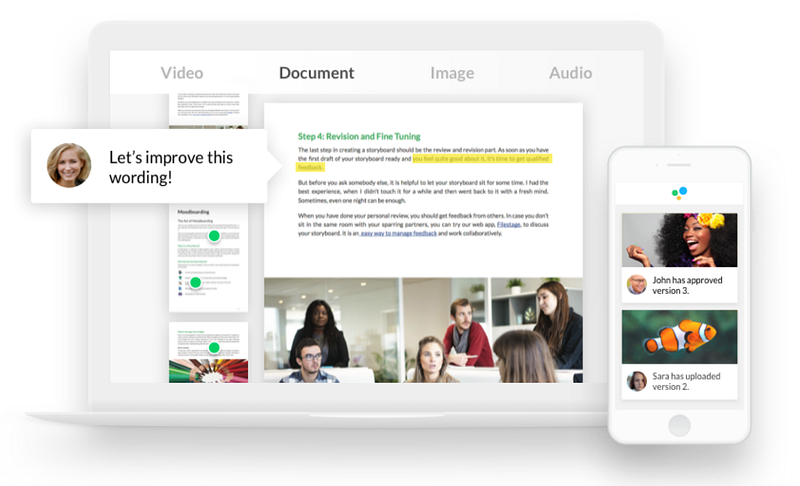
Filestage is a creative project management software that works for teams of any department. Whether you are a marketing manager, a CTO, or an HR, Filestage has all the features your team needs to finish every project with success.
Features:
- Collaborate in real time.
- Comments on videos, docs, images, and audio files.
- To-do lists.
- Custom branding.
- Annotations.
- Mobile version.
- 256-bit SSL encryption for your data.
- There’s a free trial, and then starts at $89/mo regardless of your team’s size.
Pros:
- Filestage is simply great for streamlining your work process so you know what to do next without any second guessing.
- It’s great for reviewing stuff and giving feedback.
- You can automate tasks such as sharing content with external members of the team and feedback follow ups to smooth your work process.
Cons:
- Getting used to the project dashboard might be a hassle at the beginning, but you’ll get used to it.
- Setting up task automation might be difficult.
Customer reviews of Filestage:
“Super tool for easy review & collaboration — my customers love it.” — Capterra.
Proofhub
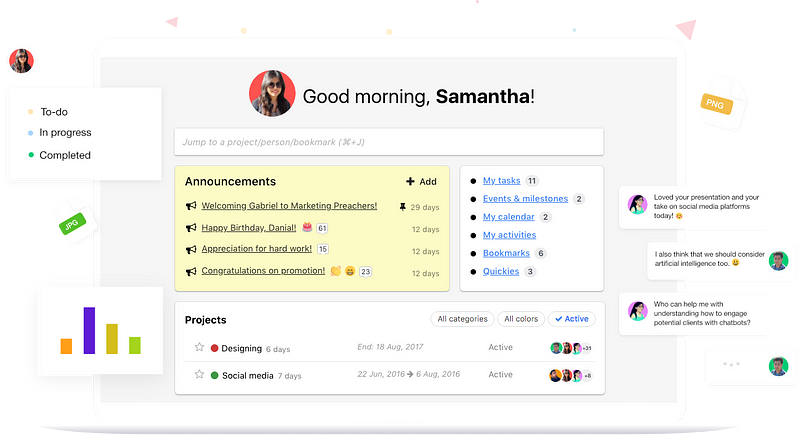
Proofhub is another enterprise task management software. It is, however, a much simpler version of Smartsheet.
With Proofhub, you won’t be driving yourself up the wall trying to figure out how certain features work.
Proofhub is quite straightforward; you’ll kick-start your project management in minutes of signing up without any hassle.
Features:
- Kanban boards.
- Gantt charts.
- Tasks.
- Mentions.
- Email-in.
- Calendar.
- Files & docs.
- Project templates.
- Reports.
- Timesheets.
- Notifications.
- Activity logs.
- Integrations.
- It offers a free trial and then starts at $89/mo.
Pros:
- Proofhub gives you access to detailed reports on your team’s performance.
- The great thing about Proofhub is that it charges you a flat monthly fee regardless of the size of your team. You can keep growing your team while keeping your costs low.
- The UI is easy to grasp; you’ll have an easy time navigating through tasks.
Cons:
- More app integrations are required.
- There’s a steep learning curve.
Customer reviews of Proofhub:
“My favorite tool is Proofhub because it’s an all-in-one tool that is packed with powerful features which helps me eliminate the need of having too many different tools in running my business.” — Jace Beeny, CEO at JaceBeeny.com.
Wrike
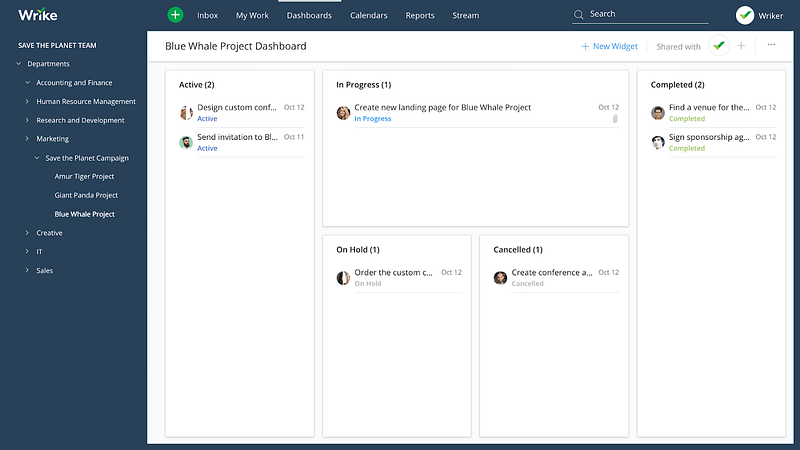
Wrike is another enterprise project management tool designed to help you clearly see the direction your project is moving toward.
It can be easily customized to your individual workflow with custom project management boards and various automations.
Features:
- Gantt charts.
- Personalize your dashboard.
- Tons of integrations.
- Enterprise-grade security.
- Real-time collaboration tools.
- Instant updates.
- Made for all types of project management. Whether you are an Agile or Waterfall fan, Wrike can be adjusted to fit your needs.
- It has a free plan for up to 5 users. Then it starts at $9.80/user/month.
Pros:
- Wrike has great dynamic reports and analytics that enable you to clearly monitor your project’s progress over time.
- It’s quite simple compared to other enterprise project management solutions. Creating tasks, subtasks, and spreading assignments with your teammates is fast and easy.
Cons:
- The file uploading process can be lengthy at times.
- Not many users are happy with Wrike’s automation system. It can be improved.
Customer reviews of Wrike:
“The best thing about Wrike is that it resembles Kanban — the Japanese project management flow tool inspired by Toyota engineers’ lean production in the 1960s.” — Sharon Van Donkelaar, CMO at Expandi.
Evernote

Although Evernote, at its core, is a note-taking app, it can be used as quite an effective project management tool as well.
With Evernote Business, you can keep track of your progress, organize your tasks clearly, access any essential docs easily, and communicate with team members frictionlessly. It has everything you need to hit the ground running.
Features:
- Timelines.
- Gantt charts.
- Milestones.
- Time tracking.
- Reporting.
- To-do lists.
- Document scanning.
- PDF & Document search.
- Share files.
- Mobile versions — Android and iOS.
- Desktop versions — Mac and Windows.
- Reminders.
- Exporter.
- Dark mode is available in Evernote for Mac, iOS, and Android.
- Evernote tutorials.
- It comes with a 30-day free trial. Then it is €13.99/user/month.
Pros:
- What’s great about Evernote is that it automatically saves your data across all your devices.
- It’s quite neatly designed; you don’t have to shuffle through a variety of features to figure out how to do something.
Cons:
- It can be buggy, especially the iOS app. This can be quite frustrating when you’re trying to note down something on the fly, and the app isn’t responding.
- Integrations can be a bit hard to set up if you are a non-tech person.
Customer reviews of Evernote:
“I love how easy it is to access your notes from anywhere. Doesn’t matter whether using my phone, Chromebook, or desktop machine, it looks good and is easy to access.” — Capterra.
Spike
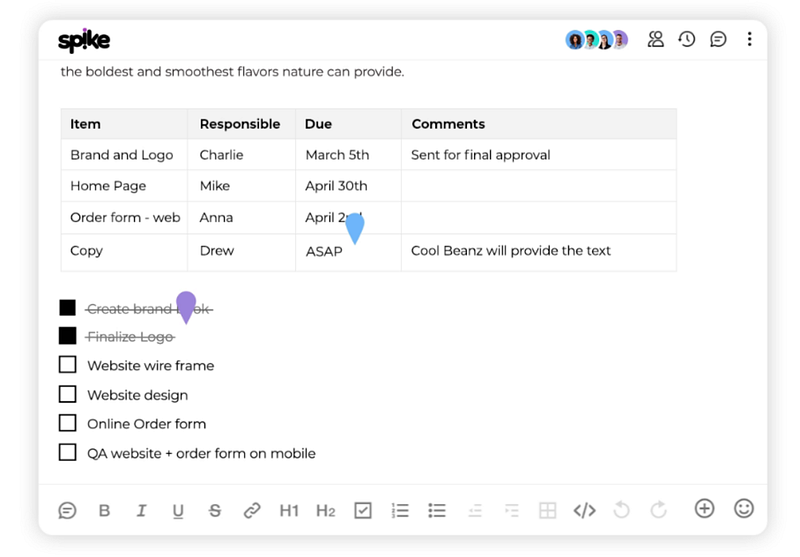
Spike brings your end-to-end project management into your inbox. From emails, chats, and calls to tasks and dashboard views, Spike puts everything in one place.
Spike works on top of your existing email and is available on iOS, Android, Mac, and Windows.
Features:
- Group chat.
- Bulk actions: delete, mark as read, archive, etc.
- Easy files access.
- Calendar.
- Advanced search.
- Video and audio calls.
- Cloud integration.
- Collaborative notes.
- There’s a free for one account. For additional accounts it starts at $4/account/month.
Pros:
- Spike removes the necessary evil — having to integrate with other 3rd party complex project management tools.
- What’s great about Spike is that it turns your emails into simple and visually appealing conversations.
- You can chat with team members through Spike even if they don’t have it.
Cons:
- Keyboard shortcuts aren’t fully customizable.
- The iPad version landscape needs further improvement.
Customer reviews of Spike:
“The overall experience has been great. One of the very few email clients available for mac which comes with a conversation like email thread.” — Capterra.
Ganttic
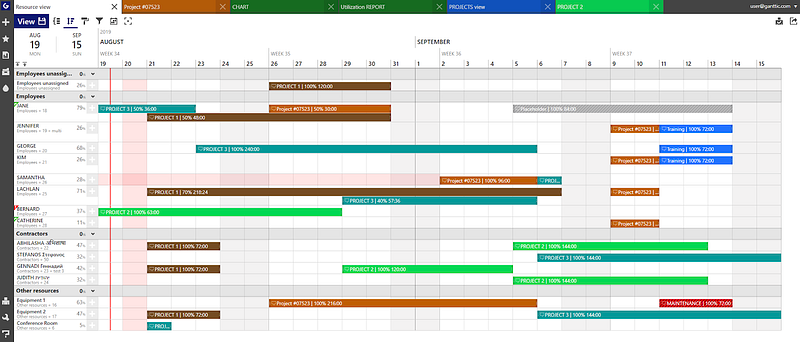
Ganttic is a project portfolio management tool, used to plan human and non-human resources, projects, and tasks.
For the past 10 years, the tool has been ideal for those looking for a middle-ground between complicated ERP software and versatile spreadsheets.
It offers users a high-level overview of each component of the planning process, increasing resource and project efficiency, transparency, and utilization.
Features:
- Cloud-based platform with real-time updates.
- Drag and drop.
- Plan from the POV of projects or resources.
- Share files.
- Gantt charts.
- Kanban views.
- Customizable, automated reports.
- Progress tracking analytics.
- Integration with Google and Outlook.
- You can try Ganttic free for 14 days. Pricing packages are scalable — as they are based on the number of resources in use.
Pros:
- The strength of Ganttic lies in its ease of use, flexibility, and shareability.
- The cloud-based platform can be updated and accessed by an unlimited number of users.
- Round the clock customer support.
Cons:
- No planning templates are available.
- The mobile app is lacking many capabilities; it is built to complement the web app.
- Although the UI is quite straightforward, it can be seen as outdated or “boring” as it mimics spreadsheets.
Customer reviews of Ganttic:
“Very fast start — I was doing what I wanted to do with Ganttic within a single minute. Great feature selection — just the right amount of what is useful.” — Capterra.
Construction Project Management Software
GanttPRO
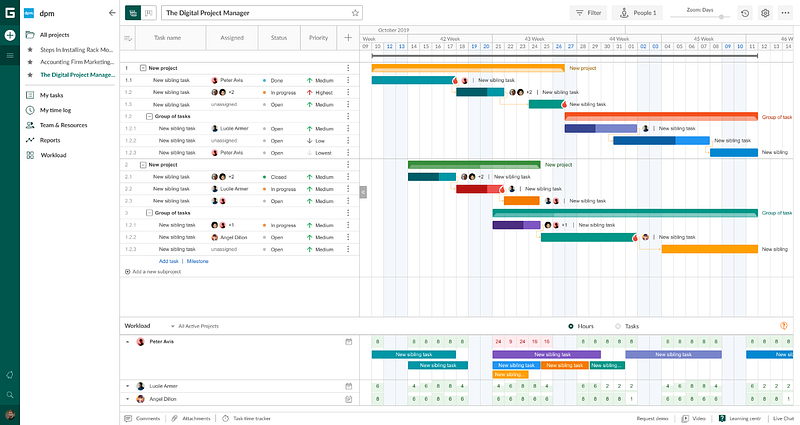
GanttPro is one of the most simple construction project management software out there.
The cool thing about GanttPro is that it provides you with robust project reports and analytics. You can clearly see the steps you need to take to move the project closer to the goal line.
Features:
- Gantt charts.
- Kanban boards.
- Time tracking.
- Budget management.
- Collaboration tools.
- Milestone tracking.
- Resource management.
- A 14-day free trial. The individual plan starts at $15 a month. The team plan starts at $8.90 per user per month.
Pros:
- The main aspect of GanttPro that makes it a powerful construction management tool is that it makes it effortless for teams to track their progress.
- Many college graduates prefer GanttPro as their starting tool — it’s quite simple, and has everything you need to hit the ground running. It’s definitely a great work organization tool for beginners.
Cons:
- There’s a sort of a learning curve.
- Chart updates can be slow at times. Even if you refresh your browser, the data will still stay out of date.
- There isn’t an “Undo” button. If you accidentally click and move something to a different place, you’re screwed.
Customer reviews of GanttPRO:
“The main business issue that we solved was the ability to track and manage workload for resources who work across multiple projects. Now it’s all in one place and scheduling projects is super easy.” — Capterra.
BuilderTrend
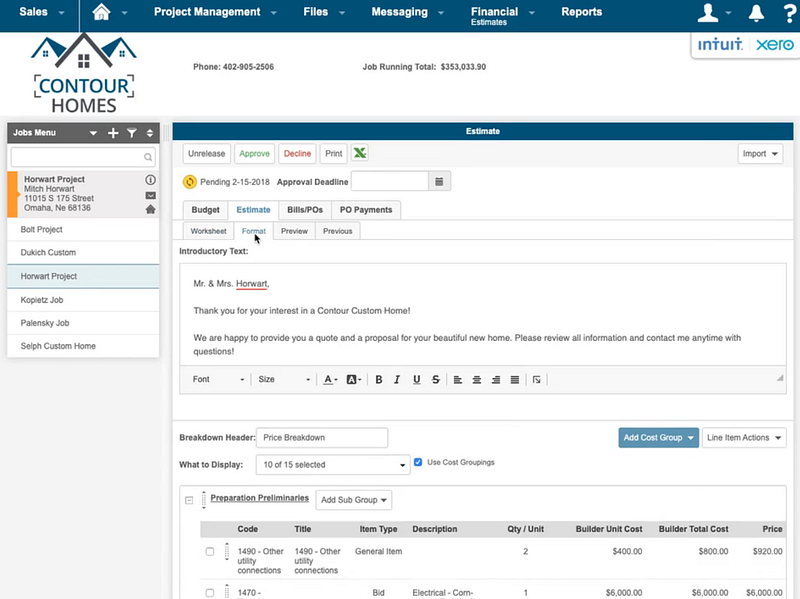
BuilderTrend is another fantastic construction management software that makes your entire work process easier.
From planning to execution, BuilderTrend has all the necessary features you need to complete your project without much hassle.
“The only thing it can’t do is manage your fantasy football team.”
Features:
- Daily logs.
- To-dos.
- Scheduling.
- Document storage.
- Messaging.
- Warranty.
- Plan Markup.
- Invoicing.
- Budget.
- Purchase orders.
- Time clock.
- A flat price of $99/mo regardless of the size of your team. On top of that, BuilderTrend offers a 30-day money back guarantee.
Pros:
- BuilderTrend’s UI is easy to grasp; you can start creating and spreading tasks across your team in a matter of minutes.
- The biggest thing about BuilderTrend is its ability to display the total project costs. It also allows you to make online payments. BuilderTrend can save you a lot of time.
- The pricing model is just a no-brainer for bigger companies. You can have a 1,000-person team and still pay only $99/mo. Compared with other tools, it’s freaking cheap.
Cons:
- The CRM component still needs more improvement according to users.
- The support team responds slowly.
- Although the UI is easy to comprehend, features such as Gantt charts might be hard to grasp if you haven’t used them before.
Customer reviews of BuilderTrend:
“My team is loving Buildertrend, they’re using it on a daily basis. We’re implementing more and more of the features.” — Matt Risinger, Owner of Risinger Build.
BuildTools

And finally, we have BuildTools, another construction project management software which is a web-based platform.
The great thing about BuildTools is that it zeroes in on your team communication. With BuildTools, you can keep internal and external project members in the loop without any hassle.
BuildTools is used by all kinds of businesses including home builders, remodelers, specialty contractors, and more. You can rest assured it’ll suit your business well if you are in the construction niche.
Features:
- Quickbooks and Xero integration.
- Proposal tracking.
- Emails.
- Messages.
- Notifications.
- Invoice management.
- Scheduling.
- Tasks.
- Photos.
- Daily logs.
- It starts at $199/mo for 3 users.
Pros:
- BuildTools is great for tracking your bottom line accurately. It’ll definitely help you make the right decisions for your company.
- With BuildTools, you can easily keep clients in the loop to ensure everyone is on the same page, and no misunderstandings occur.
Cons:
- The UI may feel a bit clunky until you get used to it.
- Occasionally, you might experience minor glitches or lags. Not a big deal though, just refresh your browser, and things will be back to normal.
Customer reviews of BuildTools:
“The features are useful and helpful to the bottom line. I can track the health of my project much easier and it helps add structure to our company organization.” — Capterra.
Open Source Project Management Software
TaskJuggler

TaskJuggler is an open source project organization software that comes as a replacement for a lot of sophisticated PM tools out there.
On top of that TaskJuggler is a free project management software.
TaskJuggler will make your entire process from planning to execution much easier to manage. It brings great communication features to the table which will help you keep everyone in the loop.
Features:
- Gantt charts.
- Task management.
- To-do lists.
- Detailed reference manual.
- Simple installation.
- Budget management.
- Runs on all Linux, Unix, Windows, macOS and several other operating systems.
- Advanced reports.
- Free to use.
Pros:
- TaskJuggler is suitable for all kinds of projects — from building a small cottage to planning the construction of a skyscraper.
- It’s suitable for many types of project management, especially Extreme Programming and Agile.
Cons:
- It might not be the most good looking project management tool out there. If your work environment’s appearance influences your performance, you might find it hard working with this project management tool.
Customer reviews of TaskJuggler:
“UI is pretty good and the application is highly responsive regardless of team sizes.” — G2.
Freedcamp
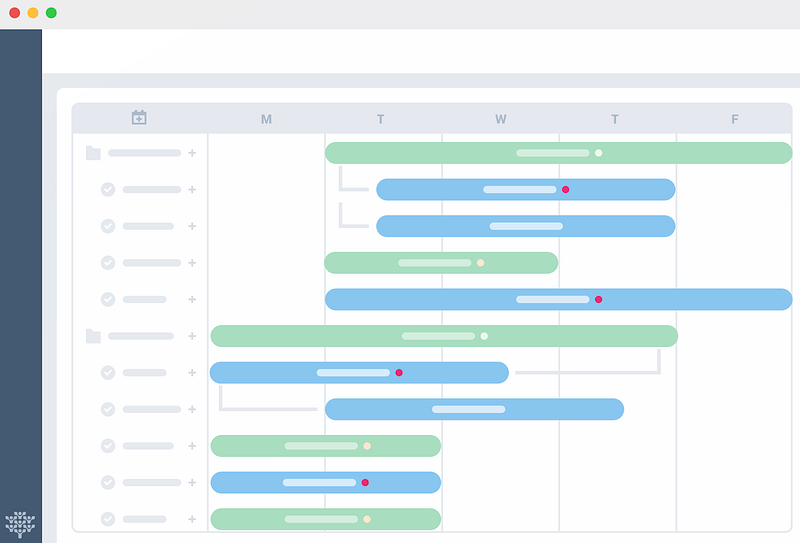
Freedcamp is another open source alternative that boasts quite a simple and user-friendly interface.
Freedcamp literally works for anything. Whether you’re making software plans as a business project manager, scheduling your wedding, or mapping out your next week’s trip to Arizona, Freedcamp has all the features necessary to make the whole process easy to manage.
Features:
- Task lists.
- Kanban board.
- Subtasks.
- Gantt charts.
- Calendar.
- Issue management software.
- Discussions.
- Milestones.
- Wiki.
- 3rd party integrations.
- Freedcamp has a free plan. Then, it starts at $1.49/user/month. It’s definitely one of the best free project management software.
Pros:
- Freedcamp is quite a solid and feature-rich project management platform that’s perfect for SMBs.
- Unlike other sophisticated tools, Freedcamp has made their app easy to grasp by even the most non-tech folks. Creating tasks, sharing files, keeping your team members up to date can be all done without any hassle.
- Freedcamp is perhaps the cheapest task management software on this list.
Cons:
- The mobile app lacks full web functionality.
- Sometimes, especially when you have hundreds of tasks running, it can be difficult to navigate through the app.
Customer reviews of Freedcamp:
“I would recommend Freedcamp to others and encourage them to do the free trial, but watch the tutorials first.” — Capterra.
OpenProject

OpenProject is another fantastic open source work management software.
Here’s more about its open-source community:
- 142 releases.
- 153 contributors.
- 8425 pull requests.
- 56417 commits.
It’s growing steadily.
The main thing about OpenProject is that it zeroes in on team communication; you’ll have an easy time keeping your team on the same page. It’s a great team management application.
Features:
- Roadmaps.
- Supports most types of project management methodologies: Agile, Kanban, and Scrum.
- Bug tracking.
- Time tracking.
- Cost reporting.
- Budgeting.
- Data security.
- Secure hosting in the EU.
- It’s $6.75/user/month but the minimum subscription time is 1 year.
Pros:
- The Gantt charts are simply fantastic. It allows you to sort your data in whatever way you like while maintaining the overall Gantt view.
- Shared timelines help you visualize the team’s progress so you know what’s the right step to take.
Cons:
- The mobile app can be hard to grasp.
- Some users believe that this is quite a burdensome resource management software.
- Getting on board can be quite a hassle initially.
Customer reviews of OpenProject:
“I don’t know who spent the time to design this program, but it has been an excellent resource for me during the few projects a year when I need a true project management tool.” — Capterra.
Redmine
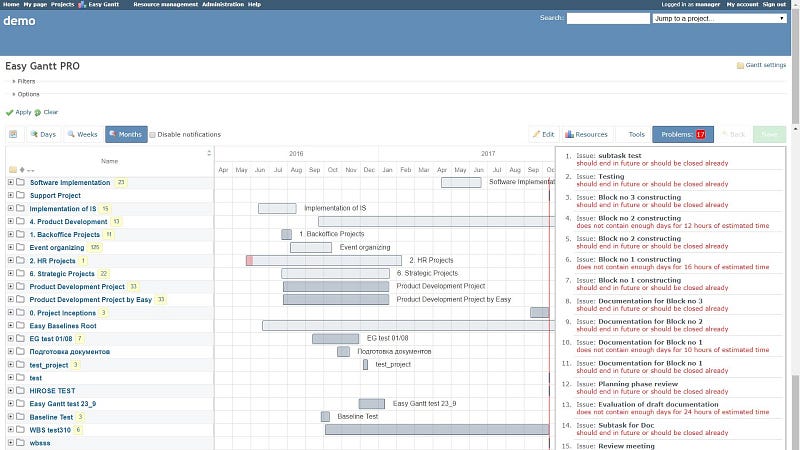
Redmine is an open source task management software written by using the Ruby on Rails framework.
It’s been on the market for over 10 years and has over 100K users.
Redmine’s plugins are definitely a good starting point for someone who is just entering the project management world.
Features:
- Issue tracker.
- Gantt charts.
- Calendar.
- News, documents & files management.
- Feeds & email notifications.
- Wikis.
- Time tracking.
- Custom fields for issues, time-entries, projects and users.
- SCM integration.
- Multiple databases support.
Pros:
- Organizing your tasks with Redmine is quite easy; you will be able to track down issues without any hassle.
- Redmine works fantastic for personal use but you can also use it for smaller business projects.
Cons:
- The design looks outdated; some customers complain it’s quite hard to get external clients on board with this software.
- The WYSIWYG editor seems clunky.
Customer reviews of Redmine:
“Redmine is my de-facto BTS every company I go to. I am very happy with its stability, versatility and easy to use for the end user.” — Software Advice.
Taiga

Taiga is another open source PM tool perfectly designed for multi-functional agile teams.
Taiga’s UI is super user friendly; you’ll hardly ever find yourself struggling with creating, spreading, or organizing daily tasks.
Features:
- WIP limits.
- Backlog & sprint planning.
- Subtasks.
- Swimlanes.
- Burndown charts.
- Sprint views.
- Customize issues.
- Notifications.
- Wikis.
- Custom real-time reports.
- There’s a free plan for up to 3 members. And then it starts at $5/user/month.
Pros:
- Taiga may not boast heaps of features, but using the tool is pretty damn easy. You can hit the ground running in a matter of minutes.
- Taiga’s mobile version is also pretty well designed. It’s neat and clean; no features are hiding in submenus.
- Taiga’s kanban view is pretty easy to grasp, and gives you a good overview of your projects. It’s a great tool for planning your Agile project down to the slightest detail.
Cons:
- Filtering your tasks in categories is darn difficult.
- Even though Taiga comes with a simple interface, sometimes, it can be rather unresponsive.
Customer reviews of Taiga:
“We love Taiga as it is both feature rich and open sourced, allowing us to self-host and customize our instance while being cost-effective and even contributing improvements back to Taiga. And for companies looking for a hosted instance with support, Taiga provides that as well.” — Kevin Payravi, Director at Nookipedia.
Conclusion
Of course, my personal recommendation is Codegiant, but I’m biased.
So, have you tried any of these? Which one is your favorite? Which one would you recommend?
Leave a comment, please. I read all the messages.
Stay unparalleled,
